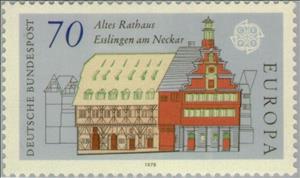Stamp: C.E.P.T.- Monuments - Old Town Hall Esslingen (Germany, Federal Republic 1978)
C.E.P.T.- Monuments - Old Town Hall Esslingen (Germany, Federal Republic 1978)
22 May (Germany, Federal Republic ) within release C.E.P.T.- Monuments goes into circulation Stamp C.E.P.T.- Monuments - Old Town Hall Esslingen face value 70 German pfennig
| Stamp C.E.P.T.- Monuments - Old Town Hall Esslingen in catalogues | |
|---|---|
| Michel: | Mi:DE 971 |
| Stamp Number: | Sn:DE 1272 |
| Yvert et Tellier: | Yt:DE 818 |
Stamp is vertical format.
Also in the issue C.E.P.T.- Monuments:
- Stamp - C.E.P.T.- Monuments - Old Town Hall Bamberg face value 40;
- Stamp - Old Town Hall Regensburg face value 50;
- Stamp - C.E.P.T.- Monuments - Old Town Hall Esslingen face value 70;
Stamp C.E.P.T.- Monuments - Old Town Hall Esslingen it reflects the thematic directions:
A house is a single-unit residential building. It may range in complexity from a rudimentary hut to a complex structure of wood, masonry, concrete or other material, outfitted with plumbing, electrical, and heating, ventilation, and air conditioning systems. Houses use a range of different roofing systems to keep precipitation such as rain from getting into the dwelling space. Houses generally have doors or locks to secure the dwelling space and protect its inhabitants and contents from burglars or other trespassers. Most conventional modern houses in Western cultures will contain one or more bedrooms and bathrooms, a kitchen or cooking area, and a living room. A house may have a separate dining room, or the eating area may be integrated into the kitchen or another room. Some large houses in North America have a recreation room. In traditional agriculture-oriented societies, domestic animals such as chickens or larger livestock (like cattle) may share part of the house with humans.
A monument is a type of structure that was explicitly created to commemorate a person or event, or which has become relevant to a social group as a part of their remembrance of historic times or cultural heritage, due to its artistic, historical, political, technical or architectural importance. Examples of monuments include statues, (war) memorials, historical buildings, archaeological sites, and cultural assets. If there is a public interest in its preservation, a monument can for example be listed as a UNESCO World Heritage Site. The Palgrave Encyclopedia of Cultural Heritage and Conflict gives the next definition of monument:
The European Union (EU) is a supranational political and economic union of 27 member states that are located primarily in Europe.The Union has a total area of 4,233,255 km2 (1,634,469 sq mi) and an estimated total population of over 448 million. The EU has often been described as a sui generis political entity (without precedent or comparison) combining the characteristics of both a federation and a confederation
The European Conference of Postal and Telecommunications Administrations (CEPT) was established on June 26, 1959, as a coordinating body for European state telecommunications and postal organizations. The acronym comes from the French version of its name Conférence européenne des administrations des postes et des télécommunications.
The Europa postage stamp (also known as Europa - CEPT until 1992) is an annual joint issue of stamps with a common design or theme by postal administrations of member countries of the European Communities (1956-1959), the European Conference of Postal and Telecommunications Administrations (CEPT) from 1960 to 1992, and the PostEurop Association since 1993. Europe is the central theme. EUROPA stamps underlines cooperation in the posts domain, taking into account promotion of philately. They also build awareness of the common roots, culture and history of Europe and its common goals. As such, EUROPA stamp issues are among the most collected and most popular stamps in the world. Since the first issue in 1956, EUROPA stamps have been a tangible symbol of Europe’s desire for closer integration and cooperation.
The City Halls are part of a market complex designed by John Carrick in 1882, but the grand hall itself was designed by George Murray and opened in 1841. It was the first hall suitable for large gatherings and concerts to be built in the City and played host to the likes of Benjamin Disraeli, Charles Dickens, Hungarian patriot Lajos Kossuth and William Ewart Gladstone. From its early days it hosted a wide variety of popular and classical concerts including those by touring groups such as Louis-Antoine Jullien's celebrated London-based orchestra and Charles Halle's orchestra from Manchester. Glasgow's first regular orchestral subscription concert series, played by an orchestra managed by the Glasgow Choral Union, was given in the grand hall from 1874 until the opening of the much larger St Andrew's Hall in 1877. Arthur Sullivan was its conductor for two seasons from 1875 to 1877. The Old Fruitmarket directly adjoins the grand hall and was a functioning market until the 1970s after which it was in occasional use for jazz and folk music events. The adjoining buildings were home to bustling produce markets such as the fresh fruit and flower market and the cheese market.






